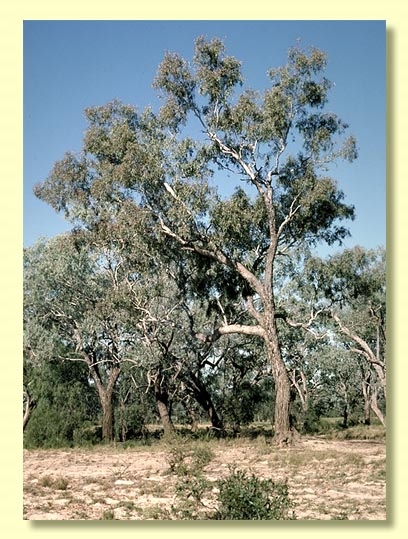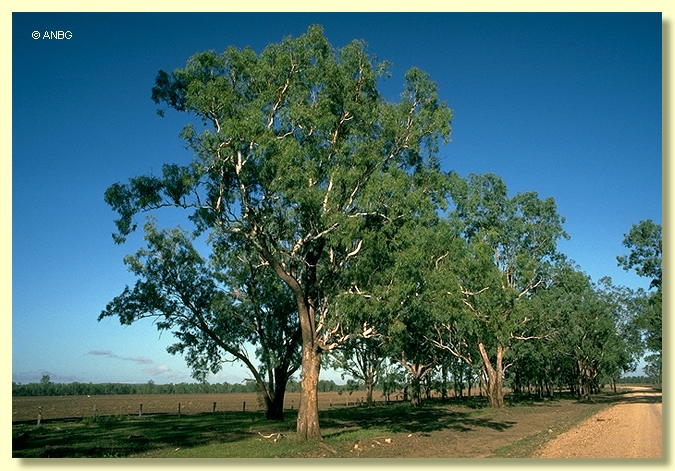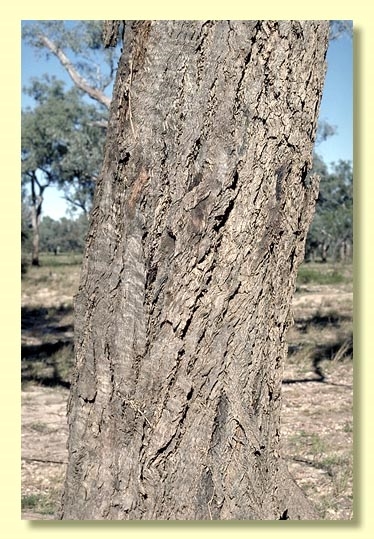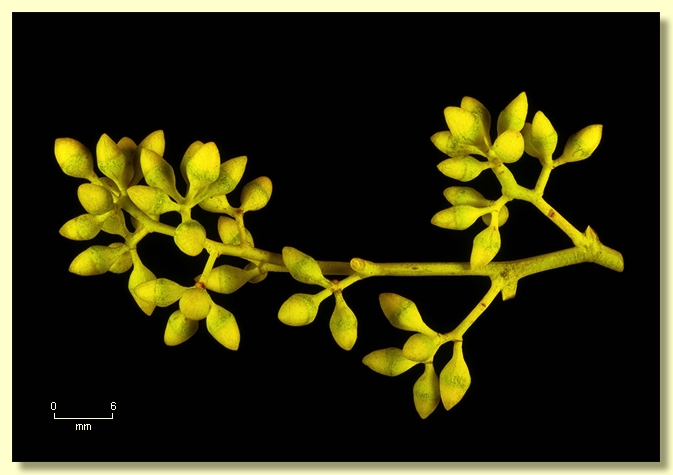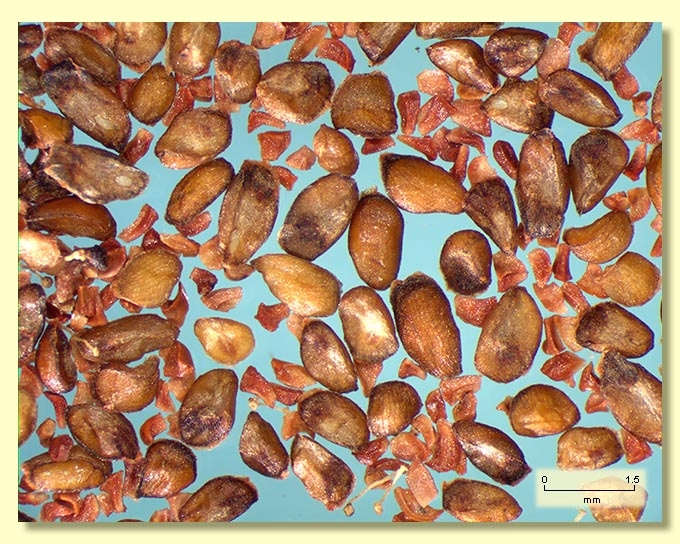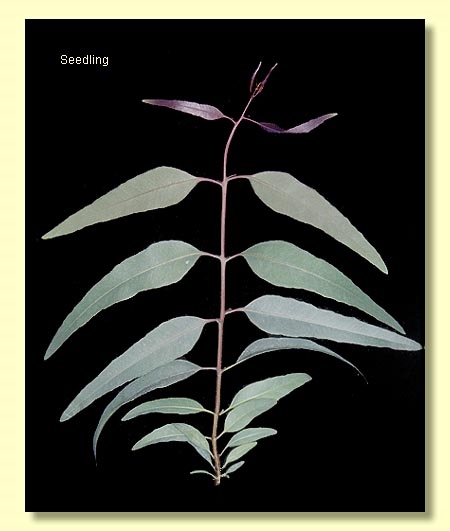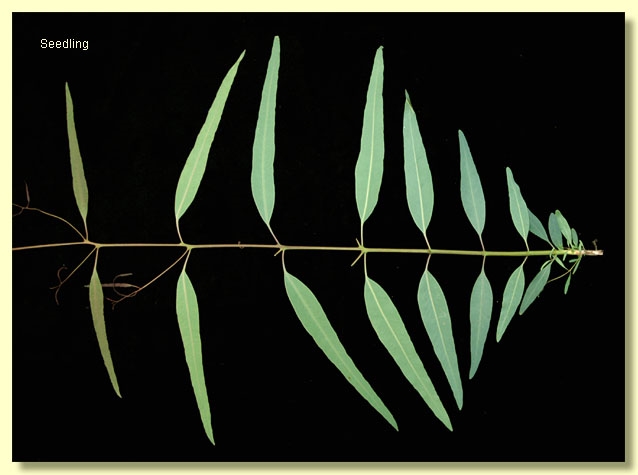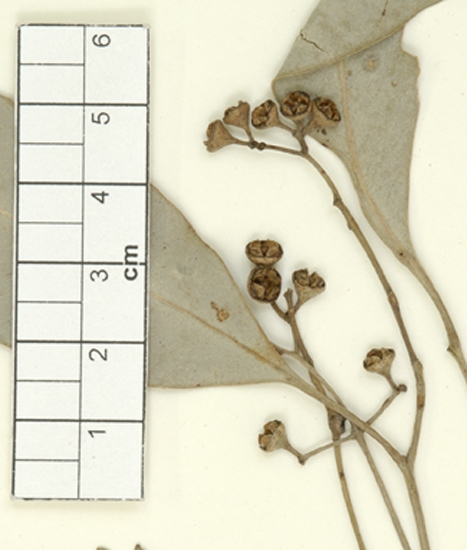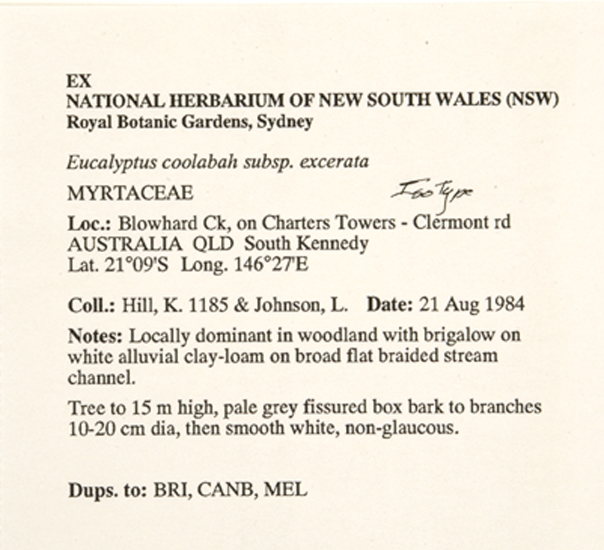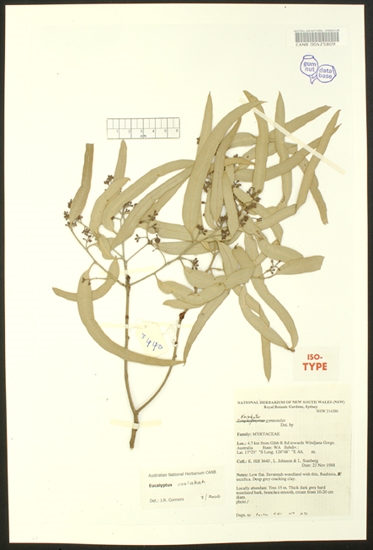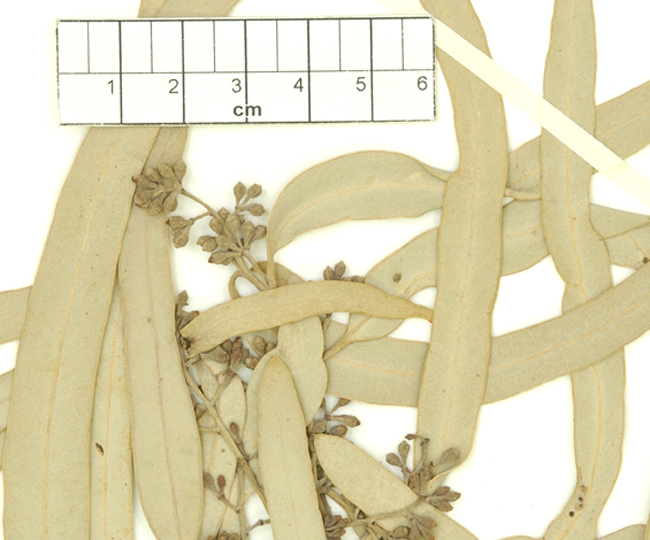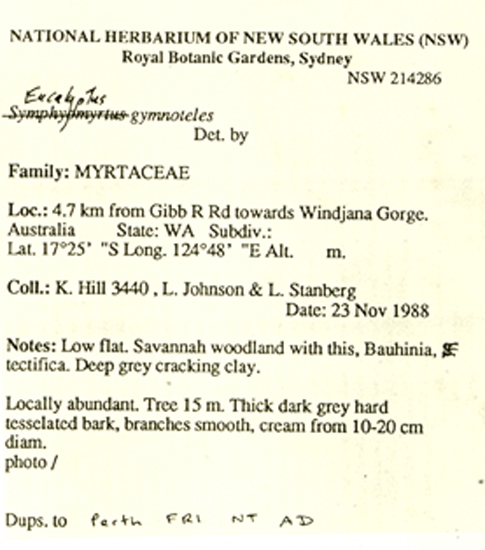Euclid - Online edition
Eucalyptus coolabah
Eucalyptus | Symphyomyrtus | Adnataria | Apicales | Aquilonares | Protrusae
T: Bogan R., near Coolabah, NSW, 26 Mar. 1904, J.H.Maiden & J.L.Boorman s.n.; lectotype: NSW 33887, fide L.A.S.Johnson & K.D.Hill, Telopea 4: 63 (1990).
E. raveretiana var. jerichoensis Domin, Biblioth. Bot. 89: 464 (1928). T: Jericho, Qld, Mar. 1910, K.Domin 9183; holo: PR.
E. coolabah Blakely & Jacobs var. arida Blakely, Key Eucalypts 246 (1934). T: S.A., Kopperamana, Cooper Creek, H.Basedow 17 Nov. 1919; lecto: NSW 10046, fide L.Johnson & K.Hill, loc. cit.; iso: BRI.
E. coolabah Blakely & Jacobs subsp. excerata L.A.S.Johnson & K.D.Hill, Telopea 4: 66 (1990). T: Queensland, Blowhard Creek, Charters Towers to Clermont road, 21 Aug. 1984, K.D.Hill 1185 & L.A.S.Johnson; holo: NSW; iso: BRI, CANB, MEL.
Tree to 10 m tall. Forming a lignotuber.
Bark rough on part or all of trunk, sometimes extending to the largest limbs, box-type or sometimes tessellated, grey, grey-brown or blackish, upper bark smooth, powdery, white, cream, pale grey or pink.
Branchlets lack oil glands in the pith; non-glaucous or rarely glaucous.
Juvenile growth (coppice or field seedlings to 50 cm): stems usually square in cross-section; juvenile leaves always petiolate, opposite, a few pairs then alternate, lanceolate, 4–13 cm long, 0.5–3 cm wide, base tapering to petiole, dull, blue-green to blue-grey or slightly glaucous.
Adult leaves alternate, petiole 0.8–2 cm long; blade lanceolate to falcate, 8–17 cm long, 1–2.5 cm wide, base tapering to petiole, concolorous, dull, green to blue-green or grey-green, side-veins greater than 45° to midrib, dense to very densely reticulate, intramarginal vein parallel to and just within margin, oil glands obscure or absent, when present, sparse intersectional.
Inflorescence mostly terminal compound, peduncles 0.3–1 cm long, buds 7 per umbel, pedicels 0.1–0.4 cm long. Mature buds ovoid, 0.3–0.5 cm long, 0.2–0.4 cm wide, often glaucous, or yellow, scar present (outer operculum lost early), operculum conical, stamens irregularly flexed, anthers adnate, cuboid to globular, dehiscing by broad lateral pores, style long, stigma blunt, locules 3 or 4, the placentae each with 4 vertical ovule rows. Flowers white.
Fruit pedicellate (pedicels 0.1–0.3 cm long), rarely subsessile, hemispherical or obconical, 0.2–0.4(0.5) cm long, 0.3–0.5 cm wide and long, thin-walled, disc descending, valves 3 or 4, strongly exserted.
Seeds brown to reddish brown to yellow-brown, lustrous, 1–2 mm long, ovoid and slightly angular to flattened-ovoid, dorsal surface shallowly reticulate, hilum ventral.
Cultivated seedlings (measured at ca node 10): cotyledons reniform to oblong; stems square in cross-section; leaves always petiolate, opposite for 4 to 9 nodes then alternate, narrowly lanceolate, 4.5–16.5 cm long, 0.9–3 cm wide, dull, grey-green or slightly glaucous.
Flowering has been recorded in January, March, April, May, July, September, November and December.
A small to medium-sized box tree widespread over inland eastern Australia, Central Australia and the southern fringe of the Kimberley region of Western Australia. In Queensland Eucalyptus coolabah occurs from south of Cloncurry to Charters Towers, extending almost to the coast near Bowen and Rockhampton, and south into the Darling River basin (but excluding the Darling Downs pastoral district) as far south as Menindee in New South Wales, west along the river systems that drain from Queensland and the Northern Territory into the Lake Eyre basin of South Australia, extending through Central Australia to the southern Barkly Tablelands, and in Western Australia confined to the catchment of the Fitzroy River. E. coolabah occurs on occasionally flooded heavy-soiled plains and banks of streams that flow too intermittently to support the river red gum, E. camaldulensis. E. coolabah is a straggly tree always with some rough bark over part or all of the trunk but with the upper trunk and branches smooth. Adult leaves are dull green to greyish green. Small ovoid buds are borne in profusion in branched clusters at the ends of branchlets in late spring/early summer and are often glaucous. Fruit are thin-walled, 0.3–0.5 cm diameter with broad-based valves conspicuously exserted.
E. coolabah is most closely related to E. microtheca, which is usually found in similar habitats to the north of the distribution of E. coolabah, and also related to the hardy E. victrix, which occurs in even drier habitats of central and Western Australia. E. microtheca differs by having well-developed rough box-type bark to the small branches. Conversely, E. victrix differs by having smooth powdery white bark over the entire trunk and branches. Another closely related member of this group is E. acroleuca from Cape York Peninsula. It is similar to E. coolabah in having basal rough bark and conspicuous smooth bark on the upper trunk and branches. E. coolabah differs by having hemispherical to obconical fruit with strongly exserted valves. (E. acroleuca has cup-shaped fruit with enclosed valves.)
In the south-eastern part of its distribution E. coolabah is most likely to be confused with another floodplain species, E. largiflorens, but the latter has extensive well-developed rough box-type bark to the smaller branches, narrower juvenile and adult leaves and thicker-walled fruit with enclosed valves. A third riparian and floodplain species, River red gum (E. camaldulensis), differs in being a larger smooth-barked tree with buds in axillary clusters, fruit that are not fragile and have a prominent raised disc, and seed that are cuboid, smooth and yellow.
In the classification of Brooker (2000) Eucalyptus coolabah belongs in Eucalyptus subgenus Symphyomyrtus section Adnataria (the boxes) because the buds have two opercula, ovules are in four rows, seeds are flattened-ovoid, cotyledons are reniform, and anthers are rigid on the staminal filaments. Within section Adnataria, E. coolabah belongs to a subgroup of box species with mostly tropical distribution, series Aquilonares subseries Protrusae, having inflorescences terminal on the branchlets, adult leaves very densely reticulate and fruit that are small, fragile and mostly have exserted valves. The number of species in this taxonomic series is contentious.
Some recent eucalypt botanists have included E. coolabah in E. microtheca (Boland et al. 1984, Chippendale 1988), whilst others (Hill & Johnson 1994) recognised eight species and three subspecies in this same group of plants. The authors of EUCLID recognize E. coolabah, E. microtheca, E. acroleuca and E. victrix on the basis that collectors can usually tell them apart if notice is taken of the extent of rough and smooth bark (from completely smooth to completely rough to the twigs), and if mature fruit is available for inspection. Collectors may need to revisit trees to ensure fruit is ripe to aid positive identification, but note that ripe fruit soon releases its seed and the fruit, being fragile and on thin pedicels and peduncles, soon falls to the ground.

